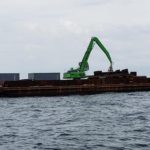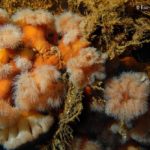The ocean floor off Long Island’s south shore slopes very gradually from the tidal zone to deep water canyons hundreds of miles away. Unlike other marine environments that feature rocky outcroppings, coral reefs, geological rifts and other structural elements, the seabed here is mostly a flat, featureless sandy plain. New York State’s Artificial Reef Program changes all of that.
Words & Photos by Michael Salvarezza and Christopher P. Weaver
SCUBA Divers everywhere are familiar with the concept of artificial reefs. Anyone who has visited a shipwreck has seen firsthand how nature reclaims man-made objects for its own. Swimming through these shipwrecks, divers observe how marine growth attaches to the hard surfaces of the wrecks while free swimming fish seek shelter in their protective confines. Indeed, soon after a ship has sunk, a thriving marine environment has emerged.
Although the vast majority of sunken vessels worldwide have resulted from unintentional sinkings, the idea of creating artificial reefs by intentionally sinking ships has gained popularity in recent years. Programs to deposit obsolete ships and other unwanted material have been implemented in many states and around the world with great success. With these reefs come increased aggregations of marine life, improved fishing for recreational fishermen and better dive opportunities for SCUBA divers.
The New York State Artificial Reef Program was officially created in 1962. It currently consists of 12 different artificial reef sites around Long Island: two in the Long Island Sound, two in the Great South bay and eight in the Atlantic Ocean south of the island. These reefs are constructed of purposely sunk vessels, recycled construction material, clean rock and steel and other material. As with all artificial reef programs, the material was thoroughly cleaned and decontaminated prior to being placed in the ocean.
For years, local divers and fishermen advocated for the expansion of this system of reefs. The Long Island Divers Association (LIDA) was a part of that advocacy effort and in 2018, their efforts were rewarded with a decision by New York Governor Andrew Cuomo to commence the largest expansion of these reefs in State history. As a result, tons of recycled material, including boats, barges and other material were deployed on the existing reef sites to further increase their profile and footprint on the ocean floor.
Perhaps the most interesting part of this expansion was the inclusion of material from the recently demolished Tappan Zee Bridge in this effort. Steel trusses, pipes, girders, concrete panels and much more have found a new home on the reefs off Long Island. Local divers now have the opportunity to dive on material many of them drove over for years as they crossed the venerable Tappan Zee Bridge.
New York State is seeking to continue this expansion significantly by depositing tons of additional material on the existing reefs and by creating four new reef sites.
Part of the current proposal calls for increasing the 14-acre Moriches Reef to 850 acres, taking the Shinnecock Reef from 35 acres to 850 acres and growing the 413-acre reef near Rockaway to 635 acres. The plan also calls for quadrupling the size of the McAlister Grounds off Jones Beach from 115 acres to 425 acres.
New reefs are to be created near the Huntington-Oyster Bay border, off Port Jefferson and near Mattituck. A fourth new site is being called Sixteen Fathom and will be an 850-acre site about 12 miles out in the Atlantic Ocean south of the Nassau-Suffolk County border.
The Department of Environmental Conservation (DEC) has studied the effects of creating Artificial Reefs in this area for decades and have documented increases in populations of marine life in these areas. But fishermen and divers can also attest to these increases firsthand. Fishermen report higher numbers of Atlantic Cod, Blackfish, Black Sea Bass, Scup and other popular sportfish. Divers see more American Lobster, Bergall, Conger Eels, Ocean Pout and Red Hake along with crabs and other crustaceans and shellfish.
At a recent public hearing on this project, Chris LaPorta, the DEC’s reef program coordinator, stressed that this program is not a form of “ocean dumping”, noting that all of the material is carefully prepared prior to its placement in the water. He also sought to clarify that this is not a means to “repair” the environment. Rather, it is best characterized as “enhancing the environment” by creating new places for marine life to inhibit.
LIDA President Barry Lipsky, who has worked directly with Governor Cuomo to represent the diving community’s perspective, says “The artificial reefs create diving opportunities for all divers interested in seeing marine life and exploring new places. This can only help the diving industry and the local economy.”
Artificial reefs have garnered positive reviews across the country and around the world. New York State’s initiative to commit more resources, material and budget to this effort underscores its commitment to both the marine environment and the local economy. Material that would otherwise lay unused in landfills, consuming dwindling resources and space, can now find a new life as part of a thriving underwater ecosystem that benefits marine life, fisherman, SCUBA Divers and the economy. That’s what we call a win-win-win-win!
New York State Artificial Reef Locations
- Atlantic Beach Reef
- Fire Island Reef
- Hempstead Reef
- Kismet Reef
- Matinecock Reef (Long Island Sound)
- McAllister Grounds
- Moriches Reef
- Rockaway Reef
- Shinnecock Reef
- Smithtown Reef (Long Island Sound)
- Twelve-Mile Reef
- Yellowbar Reef (Great South Bay)
For More Information
Department of Environmental Conservation
www.DEC.NY.GOV
artificialreefs@dec.ny.gov
Long Island Divers Association (LIDA)
www.lidaonline.com
___________________________________
Words & Photos by Michael Salvarezza and Christopher P. Weaver
- Author Christopher Weaver examines the reefs
- Material from the demolished Tappan Zee Bridge being deposited
- Material from the demolished Tappan Zee Bridge being deposited
- Decommissioned working boats and barges are part of the reef material
- Depositing reef materials is a large effort
- LIDA President Barry Lipsky on site with New York Governor Mario Cuomo and Suffolk County Executive Steve Bellone
- Invited guests watch as the reef material is deposited
- Author Michael Salvarezza photographing the reefs
- Anemones blanket the hard surfaces of the reefs
- A Calico Crab finds a home
- Blue Mussels are among the first organisms to take up residence
- The Dauntless before her sinking as part of the artificial reef system
- Crabs and other crustaceans move in quickly
- The authors with Barry Lipsky and Chris LaPorta, Artificial Reef Program Coordinator for the New York State DEC
- Skates are often seen on the reefs
- Bergall find the reef structures to their liking
- Ocean Pout often make their home in the nooks and crannies of the reefs
- Divers can find groups of anemones on the reefs
- Frilled Anemones dominate the reefs
- Scallops are often seen on the wrecks and reefs
- Whelks crawl along the ocean floor
- Ocean fish are attracted to the shelters of the reefs
- Crabs scurry along the bottom
- The largest expansion of the Artificial Reef program will significantly add to the underwater reef coverage (Courtesy New York State Department of Environmental Conservation)





























